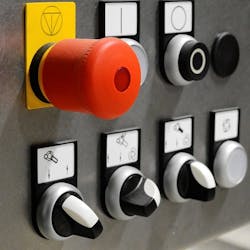- How are end users implementing stack lights on multi-station assembly lines?
- What are some of the best ways to indicate alarms and confirm that appropriate operator action has occurred?
- How can stack lights improve machine or system productivity?
- How do I indicate and describe alarms without overloading an operator with too much information?
Why are we still using stack lights, annunciators and push buttons? Are machine designers going for a retro look with these antiquated analog components? Or maybe it’s the hipster in them, wanting to show that they were building machines with interface devices before interface was cool. “That annunciator sounded way better on vinyl.”
Human-machine interface (HMI) can offer a digital version of almost any button, knob or light, but analog still has its place on machines, whether it’s for its ruggedness, for no-look interaction or for situations in which touchscreen operation isn’t an option.
We posed several questions regarding these time-tested components to a panel of industry veterans to see what light their experience and expertise might shed on the subject.
Why are operator buttons needed if an HMI can provide the same function?
Matt Newton is director of technical marketing at Opto 22.
So, the idea is to use these light rings out on the machine where you want some remote functionalities but you don't need a whole HMI. Maybe you are changing a blanket or roll out on a process station of a flexo press.
These light rings come in all kinds of custom configurations, as well, including light rings integrated into HMI panels.
We also do a big business in custom HMI panels that include all manner of push buttons. You tend to see these on CNCs, plastics machinery and the like. Ultimately, the proliferation of 16x9 format HMI panels, where you never have to navigate away from the home screen, will tend to replace large banks of dedicated push buttons.
But there will always be a use for simple-to-use, remote on/off/jog/forward/reverse kinds. It's just that they are going to be intelligent, networked and, who knows, connected to the edge.
John Kowal, director, business development, B&R Industrial Automation.
Michael O’Neill is president at Werma-USA.
Don King is product manager at Rockwell Automation.
Will Healy III is marketing management director at Balluff.
Some machine functions are time sensitive, too. This includes jogging of motion-control devices where the propagation delay of an HMI is detrimental to real-time response. Modern HMIs with high-speed Ethernet communications to PLCs or PACs and motion controllers are very fast; however, they will inherently have delays compared to hardwired operators to I/O points. Another example is the use of an analog joystick to immediately modify speed of a VFD-controlled motor or a servo-driven axis of motion. The dynamic response of an analog joystick is considerably faster, more reliable and easier to use than an HMI touch object.
Lee Clore is owner/controls designer at Onyx Industries.
Sopan Khurana is applications engineer at Patlite.
Robb Weidemann is senior business development manager at Banner Engineering.
Thomas Putz is sales manager at Auer Signal.
Zach Tinkler is U.S. product manager, control and signaling at Schneider Electric.
HMIs first came on the scene in the 1980s, with the real growth and innovation starting in the mid-1990s when lower-cost, more-reliable LCD and touchscreen technology became prevalent. Before this time, push buttons were the de facto standard for human-to-machine interaction. With a couple decades to look back on, what has happened to the pilot device market since the growth of HMIs?
Looking at the U.S NEMA reported market sizes for pilot devices and HMIs since 2001, you will find that both have grown in size. Today, both pilot devices and HMIs are similar in market size, while push buttons still maintain the advantage. Although HMI grew at a higher rate, the push-button market has also grown in size. It is fair to say the market says both technologies are needed.
Outside of some safety and industry standards, such as emergency stop and two-hand control, HMIs are viable and can do everything a pilot device can. What determines selection of one technology over another depends on different factors. Although some manufacturers build HMIs that have control capabilities built-in, the majority of HMIs today must communicate to a controller over a network to actually function. When the application doesn’t include a controller, then pilot devices are the ideal and sometimes only choice. Other factors are the number of functions needed. If you only have a few buttons and indicators, it’s sometimes difficult to justify a full HMI. Personal preference, know-how, simplicity, tactile feedback and muscle memory of repetitive functions are all examples of why customers select pilot devices over or in addition to HMIs.
Some people might be inclined to believe push buttons are not a product that can be innovative and high-tech, but nothing could be further from the truth.
Michael Day is industrial control products market development manager at Siemens.
ALSO READ: Harsh environments call for more rugged components
Mike Bacidore is the editor in chief for Control Design magazine. He is an award-winning columnist, earning a Gold Regional Award and a Silver National Award from the American Society of Business Publication Editors. Email him at [email protected].
About the Author
Mike Bacidore
Editor in Chief
Mike Bacidore is chief editor of Control Design and has been an integral part of the Endeavor Business Media editorial team since 2007. Previously, he was editorial director at Hughes Communications and a portfolio manager of the human resources and labor law areas at Wolters Kluwer. Bacidore holds a BA from the University of Illinois and an MBA from Lake Forest Graduate School of Management. He is an award-winning columnist, earning multiple regional and national awards from the American Society of Business Publication Editors. He may be reached at [email protected]

Leaders relevant to this article:













